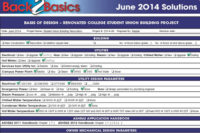Since the University of Texas at Austin (UT Austin) first opened its doors in 1883, the school has grown to employ more than 3,000 professors, enroll 51,000 students, and has garnered an impressive global reputation. UT Austin has a 135-year history of sustainability and takes pride in its pursuit of sustainable energy solutions. As the university grows, it continues to seek out innovative technologies that offer the optimal solution for both new buildings and retrofits.
Throughout the years, there were countless initiatives to reduce UT Austin’s environmental impact. The Carl J. Eckhardt Combined Heating and Power Complex was built to provide energy for the campus and decrease the load on the city’s power grid. This power plant has achieved an efficiency of more than 85% — twice that of a typical power plant.
Ongoing advancements have allowed the system to use the same amount of fuel today as in 1976 while doubling the amount of served space. Because optimal energy production efficiency had been achieved, annual savings opportunities have shifted to the demand side. In 2010, the energy management & optimization (EMO) team at the University of Texas at Austin began a 20-year plan to reduce average energy use intensity (EUI) on the main campus by 20%.
After this goal was met early in 2018, a new annual goal was set to reduce energy use by 2%. This reduction in energy consumption has been taking place even while the university continues to grow. Recently, UT Austin converted an old technology incubator facility with dense equipment cooling loads — known as the West Pickle Research Center — into new office space for faculty. Because the offices do not require as much cooling as the lab, the two constant-speed, oil-lubricated centrifugal chillers that had previously supported the building were no longer appropriate.
There was a 650-ton (2,285-kW) chiller that provided too much cooling and a 200-ton (703 kW) unit that did not provide enough. The chillers were installed in 1983 and ran on R-11, an ozone-depleting refrigerant that is now banned for use in new equipment via the Montreal Protocol. The chillers were past due for an upgrade and operating them wasted a lot of energy.
UT Austin replaced the two older chillers in the Pickle Research Center with a 300-ton YORK® YZ Magnetic Bearing Centrifugal Chiller. Installed in 2018, the chiller offers a perfect middle ground between the two previous chillers and was fondly nicknamed the “Goldilocks chiller” because it was just the right size for the new building load.
“We used to have to hold the entering condenser water temperature at 65ºF to run our chillers during the winter months,” said Juan Ontiveros, associate vice president, utilities, energy and facilities management at UT Austin. “The YZ Chiller is able to take advantage of our entering condenser water temperatures down to 45º, greatly reducing the energy consumption.”
Flexible control options offered by the variable speed drive can meet a shifting building load, helping curb unnecessary energy consumption. Additionally, the magnetic bearing technology in the YORK YZ significantly increased reliability while decreasing downtime and maintenance requirements.
After installing the YZ Chiller, UT Austin realized an estimated 330,000 kWh or $23,000 in annual savings. The high efficiency of the YZ makes an appreciable difference in energy costs over the year compared to the old chillers previously in the building.
One of the reasons the YZ chiller can save energy throughout the year is its ability to run at exceptionally low tower water temperatures thanks to its wide operating map. Utilizing magnetic bearings eliminates minimum speeds and lubrication systems that previously limited chillers from operating at extra-low lift conditions.
The YZ is designed for real-world efficiency and operates efficiently at off-design conditions — where most chillers operate 98% of the time. Even in a warmer climate like Austin, there are still plenty of hours where the temperature is cool enough to take advantage of lower entering condenser water temperatures. Since the chiller has been in operation, exceptional efficiencies as low as 0.15 kW/ton (23 COP) have been observed.
Because the YORK YZ Chiller can easily integrate into any building setting and run efficiently, UT Austin saw immediate results. In this retrofit to an old lab facility, an immediate efficiency improvement of 15% over UT Austin’s other fully optimized plants was realized soon after starting up the chiller.




